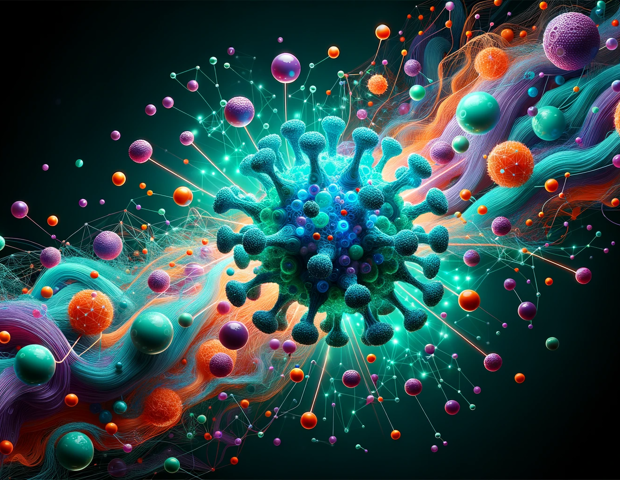A new gold-based drug can slow tumor growth in animals by 82% and target cancers more selectively than standard chemotherapy drugs, according to a study by Australian and Indian researchers.
The RMIT University study published in the European Journal of Medicinal Chemistry reveals a new gold-based compound that's 27 times more potent against cervical cancer cells in the lab than standard chemotherapy drug cisplatin.
It was also 3.5 times more effective against prostate cancer and 7.5 times more effective against fibrosarcoma cells in the lab.
In mice studies, the gold compound reduced cervical cancer tumor growth by 82%, compared to cisplatin's 29%.
Project lead at RMIT, Distinguished Professor Suresh Bhargava AM, said it marked a promising step towards alternatives to platinum-based cancer drugs.
These newly synthesized compounds demonstrate remarkable anticancer potential, outperforming current treatments in a number of significant aspects including their selectivity in targeting cancer cells.
While human trials are still a way off, we are really encouraged by these results."
Suresh Bhargava AM, Director of RMIT's Centre for Advanced Materials and Industrial Chemistry
The gold-based compound is now protected by a US Patent and ready for further development towards potential clinical application.
Towards more targeted, less toxic treatment
Gold is famously known as the noblest of all metals because it has little or no reaction when encountering other substances; a property that makes it perfect for wedding rings and coins.
However, the gold compound used in this study is a chemically tailored form known as Gold(I), designed to be highly reactive and biologically active.
This chemically reactive form was then tailored to interact with an enzyme abundant in cancer cells, known as thioredoxin reductase.
By blocking this protein's activity, the gold compound effectively shuts down cancer cells before they can multiply or develop drug resistance.
Bhargava said this highly targeted approach minimizes the toxic side effects seen with the platinum-based cisplatin, which targets DNA and damages both healthy and cancerous cells.
"Their selectivity in targeting cancer cells, combined with reduced systemic toxicity, points to a future where treatments are more effective and far less harmful," Bhargava said.
This specific form of gold was also shown to be more stable than those used in earlier studies, allowing the compound to remain intact while reaching the tumour site.
Project co-lead at RMIT, Distinguished Professor Magdalena Plebanski, said along with this ability to block protein activity, the compound also had another weapon in its anti-cancer arsenal.
In zebrafish studies, it was shown to stop the formation of new blood vessels that tumours need in order to grow.
This was the first time one of the team's various gold compounds had shown this effect, known as anti-angiogenesis.
The drug's effectiveness at using these two attacks simultaneously was demonstrated against a range of cancer cells.
This included ovarian cancer cells, which are known to develop resistance to cisplatin treatment in many cases.
"Drug resistance is a significant challenge in cancer therapy," said Plebanski, who heads RMIT's Cancer, Ageing, and Vaccines Laboratory.
"Seeing our gold compound have such strong efficacy against tough-to-treat ovarian cancer cells is an important step toward addressing recurrent cancers and metastases."
Regional collaboration a key enabler
The dedicated RMIT team is collaborating with scientists at the Indian Institute of Chemical Technology (IICT) in Hyderabad under a $2million Australia-India Strategic Research Fund grant.
First author on the latest study, Dr Srinivasa Reddy, was initially a graduate from RMIT's joint PhD program with IICT and is now playing an active role in the collaborative project.
Meanwhile, RMIT Vice-Chancellor's Research Fellow Dr Ruchika Ojha has been supporting Bhargava in building and leading his Molecular Engineering Group to continue advancing innovative research into gold-based therapeutics long into the future.
"I am proud to carry forward Professor Bhargava's golden legacy, ensuring his pioneering contributions to this field continue to inspire groundbreaking discoveries," Ojha said.
Bhargava said leveraging the best minds and technical infrastructure across both Australia and India was critical to making a meaningful difference in the fight against cancer.
Gold has been a cornerstone of Indian Ayurvedic treatments for centuries, celebrated for its healing properties.
Today, gold-based cancer treatments are gaining global traction, with advancements such as the repurposing of the anti-arthritic drug auranofin, now showing promise in clinical trials for oncology.
"We know that gold is readily accepted by the human body, and we know it has been used for thousands of years in treating various conditions," Bhargava said.
"Essentially, gold has been market tested, but not scientifically validated.
"Our work is helping both provide the evidence base that's missing, as well as delivering new families of molecules that are tailor-made to amplify the natural healing properties of gold," he said.
Industry support worth its weight in gold
RMIT's research in this field over a sustained period has caught the gold industry's attention.
In October, Pallion subsidiary ABC Bullion committed an annual donation of 250 grams of pure Australian gold – valued at more than AUD $30,000 – to support the research.
Representatives of Canada's third-largest gold producer, Agnico Eagle Mines, have also visited the RMIT labs to explore collaboration opportunities.
"These endorsements highlight the social and scientific impact of our research," Bhargava said.
"There is a recognition that this is not just a scientific breakthrough but a step towards addressing a global health challenge and people want to be a part of that."
This groundbreaking project led by Bhargava and Pebanski brings together a dynamic team of young scientists including Dr Srinivasa Reddy, Dr Steven Priver, Dr Ruchika Ojha, Dr Ranjith Jakku, and Dr Tayebeh Hosseinnejad. Meanwhile, six PhD students from India, Germany, Australia, Bangladesh and Mexico have joined the effort, further strengthening the global collaboration.
Source:
Journal reference:
Reddy, T. S., et al. (2024). Gold(I) Complexes of the Type [AuL{κC-2-C6H4P(S)Ph2}] [L = PTA, PPh3, PPh2(C6H4-3-SO3Na) and PPh2(2-py)]: Synthesis, Characterisation, Crystal Structures, and In Vitro and In Vivo Anticancer Properties. European Journal of Medicinal Chemistry. doi.org/10.1016/j.ejmech.2024.117007.

 1 hour ago
1
1 hour ago
1
















.png)

.png)
.png)
.png)













 English (US) ·
English (US) ·  Hindi (IN) ·
Hindi (IN) ·